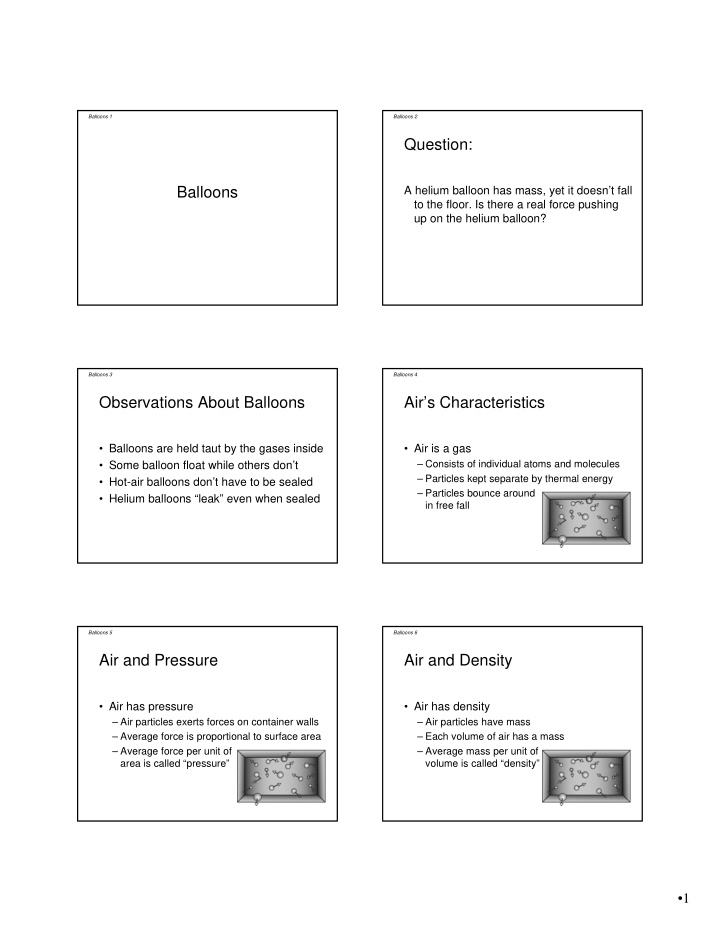



Balloons 1 Balloons 2 Question: Balloons A helium balloon has mass, yet it doesn’t fall to the floor. Is there a real force pushing up on the helium balloon? Balloons 3 Balloons 4 Observations About Balloons Air’s Characteristics • Balloons are held taut by the gases inside • Air is a gas – Consists of individual atoms and molecules • Some balloon float while others don’t – Particles kept separate by thermal energy • Hot-air balloons don’t have to be sealed – Particles bounce around • Helium balloons “leak” even when sealed in free fall Balloons 5 Balloons 6 Air and Pressure Air and Density • Air has pressure • Air has density – Air particles exerts forces on container walls – Air particles have mass – Average force is proportional to surface area – Each volume of air has a mass – Average force per unit of – Average mass per unit of area is called “pressure” volume is called “density” •1
Balloons 7 Balloons 8 Air Pressure and Density Pressure Imbalances • Air pressure is proportional to density • Balanced pressure exerts no overall force – Denser particles hit surface more often – Forces on balloon’s sides cancel – Denser air → more pressure • Unbalanced pressure exerts overall force – Forces on balloon’s sides don’t cancel – Forces push balloon toward lower pressure • Air pressure also pushes on the air itself – Air itself is pushed toward lower pressure Balloons 9 Balloons 10 The Atmosphere Archimedes’ Principle • Air near the ground supports air overhead • A balloon immersed in a fluid experience an upward buoyant force equal to the – Air pressure is highest near the ground weight of the fluid it displaces – Air density is highest near the ground • Key observations: – Air pressure decreases with altitude – A balloon feels more force at bottom than top – Imbalance yields an upward buoyant force Balloons 11 Balloons 12 Room-Air Balloon in Air Air and Temperature • A rubber balloon filled with room air • Air pressure is proportional to temperature – weighs more than the room air it displaces – Faster particles hit surface more and harder – Hotter air → more pressure – experiences a downward net force in room air – sinks in room air • Its average density > density of room air •2
Balloons 13 Balloons 14 An Aside About Temperature Hot-Air Balloon in Air • Air has temperature • A rubber balloon filled with hot air – Air particles have thermal kinetic energy – contains fewer air particles than if it were cold – Average thermal kinetic energy is proportional – weighs less than the room air it displaces to absolute temperature – experiences an upward net force in room air • SI absolute temperature: kelvins or K – floats in room air – 0 K is absolute zero — no thermal energy left • Its average density < density of room air – Step size: 1 K step same as 1 ° C step Balloons 15 Balloons 16 Helium vs. Air Helium Balloon in Air • Replacing air particles with helium atoms • A rubber balloon filled with helium – leaves particle density unchanged – has same particle density as air • all particles contribute equally to pressure – weighs less than the air it displaces – reduces the gas’s density – experiences an upward net force in air • helium atoms are less massive than air particles – floats in air – leaves the gas’s pressure unchanged • Its average density < density of room air • helium atoms travel faster & hit more often Balloons 17 Balloons 18 Question: Ideal Gas Law A helium balloon has mass, yet it doesn’t fall Pressure = Boltzmann constant · Particle to the floor. Is there a real force pushing density · Absolute temperature up on the helium balloon? • Assumes perfectly independent particles • Real particles aren’t perfectly independent •3
Balloons 19 Summary About Balloons • Balloons float when their average densities are less than that of air • Helium balloons float because helium atoms are lighter than air particles • Hot-air balloons float because hot air has lower particle density than cold air •4
Recommend
More recommend